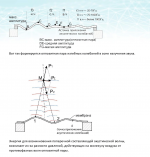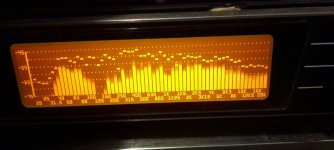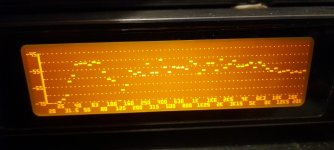I can't say what anybody else means, but bending waves and shear waves are both transverse waves. It's true that bending waves involve a bit of rotation too, but that's a minor effect. The main displacement is transverse.I haven't read the Karavashkin paper yet (link was blocked by my ISP), but my understanding is that 'transverse wave' is normally reserved for shear waves where the displacement is perpendicular to the panel, as distinct from bending waves where there is rotation involved. Could it be he means shear wave?
Eric
Alvipet,Oh yes, I expected further questions about this) Therefore, I will give you a link to another resource of Karavashkin, with his own explanations
Thanks for sharing this additional reference. I will readily admit that most of the article is beyond my comprehension, but at the same time I don't see any indication that it has any clear relation to dml/bending wave speakers. Can you direct me to any specific section that links this concept of transverse waves in air, to the performance of dml type speakers?
Eric
Has Karavashkin "thesis" had been accepted by any official scientific organisations of Ukraine or Russia, that is, especially this theory TST? Ukraine, because they are supposed to live in Kharkov. Russia, because their site has .ru in it? СЕЛФ appears to be their private business. Sure, he had once worked in the Academy of Science of the former Soviet Ukraine.Oh yes, I expected further questions about this) Therefore, I will give you a link to another resource of Karavashkin, with his own explanations
Use Epic browser, or Tor browser. Epic is better, though.I haven't read the Karavashkin paper yet (link was blocked by my ISP),
Sure. 🙂...but my understanding is that 'transverse wave' is normally reserved for shear waves where the displacement is perpendicular to the panel, as distinct from bending waves where there is rotation involved. Could it be he means shear wave?
'Scientists' write lot of bollocks to explain a simple thing.
Look hereCan you direct me to any specific section that links this concept of transverse waves in air, to the performance of dml type speakers?
Can you tell us about Mr Karavashkin, and the Special Laboratory for Fundamental Elaborations (SELF) ?? 🙂Oh yes, I expected further questions about this) Therefore, I will give you a link to another resource of Karavashkin, with his own explanations
To be honest, I don't know. Here is his autobiographical pageHas Karavashkin "thesis" had been accepted by any official scientific organisations of Ukraine or Russia, that is, especially this theory TST? Ukraine, because they are supposed to live in Kharkov. Russia, because their site has .ru in it? СЕЛФ appears to be their private business. Sure, he had once worked in the Academy of Science of the former Soviet Ukraine.
For me personally, the real results of human activity are in the first place, and not its recognition by official scientific institutions. Try to find a clear explanation of all the unusual effects of sound waves from DML panels from official science, except for the muddy concept of a diffuse field, there is nothing. And with Karavashkin, all the discovered properties of a transverse wave in a gas clearly coincide with the effects of DML panels.
If you are interested in all his scientific activities, then here you can find a lot of additional materials .Can you tell us about Mr Karavashkin, and the Special Laboratory for Fundamental Elaborations (SELF) ??
I was more interested in the low frequency response where the panel turns into pistonic motion.
It will be interesting to see what happens to the canvas art panel, proplex and my small panels when the pistonic pulse waves are cancelled?
I know very little changes higher up in the frequency response.
But it would be interesting to see this change from bendingwave, Dml, to pistonic pulse wave, if it works?
I have not been in my room for a few months, I have my proplex panels set up there at the moment.
I will let everyone know what happens as soon as I try this experiment.
Steve.
It will be interesting to see what happens to the canvas art panel, proplex and my small panels when the pistonic pulse waves are cancelled?
I know very little changes higher up in the frequency response.
But it would be interesting to see this change from bendingwave, Dml, to pistonic pulse wave, if it works?
I have not been in my room for a few months, I have my proplex panels set up there at the moment.
I will let everyone know what happens as soon as I try this experiment.
Steve.

First and only warning. Keep it civil, keep it on topic and cut the insults.
If your post got caught up in this by a quote of something that needed deleting then that goes as well.
Steve,I was more interested in the low frequency response where the panel turns into pistonic motion.
It will be interesting to see what happens to the canvas art panel, proplex and my small panels when the pistonic pulse waves are cancelled?
I know very little changes higher up in the frequency response.
But it would be interesting to see this change from bendingwave, Dml, to pistonic pulse wave, if it works?
I have not been in my room for a few months, I have my proplex panels set up there at the moment.
I will let everyone know what happens as soon as I try this experiment.
Steve.
I suppose you'd get most of the answers here. Replace the word NXT with DM (distributed mode) in some of the relevant sentences, I'm sure, you'd get the answers. You might want to look at this too.
Last edited:
Any chance of seeing close up pictures of the exciter panel back and front ?
And how they were made.
And you only use them for the midrange?
Steve.
Herb777 said "low to midrange". and the ribbon tweeter is used for the highs.Any chance of seeing close up pictures of the exciter panel back and front ?
And how they were made.
And you only use them for the midrange?
Steve.
I also tried using a tweeter in fact I bought around 7 different tweeters just to try out including a ribbon and I did not prefer any of them.
Tweeters I've tried> Mylar dome, Soft dome, ribbon, copper/berylium coated , paper cone, polycarbonate and titanium.
Out of all those tweeters the cheapest tweeter which is the paper cone at around 3 bucks each sounded the best with my DML panels. Second best and cheap is the Mylar. Which got me thinking of the Melior 1 DML panels made of Mylar sheet.
http://www.museatex.com/planar1.htm
Last edited:
Audiofrenzy.
I think this was the design NXT or what ever they were called at the time, spent rather a lot of money and time patenting?
RIP NXT.
Steve.
I think this was the design NXT or what ever they were called at the time, spent rather a lot of money and time patenting?
RIP NXT.
Steve.
Wow, haha, you are right, DPK really does claim that:Look here

I'm skeptical, I must admit.
- the Karavashkin papers read like pseudoscience to me. And the SELF laboratory seems sketchy at least.
- I had the impression that the DPK speaker was based on the Herger patent. Is that correct? And if so, whey didn't it mention this hitherto unstudied phenomenon, if it's so basic to the function of this speaker?
Eric

Well ,this is interesting .
The first picture shows the response in between the panels.
The second picture shows the response when one panel is reverse phased and when normal.
The third picture is the reversed phase only.
The response below 100hz to 40hz is pretty much unchanged.
The large dip in the 125 area which I see on various panel types which can go up to 300hz or more on certain panels.
The pistonic mode seems to fill in this area on this panel type.
I use my cone subs to fill in this area.
This was not a very scientific test as the panels were not identical, one was the 4mm proplex and the other was the 6mm proplex.
I do not at this time have identical panels 😱
I have always wondered about this dip in the area below 300hz and the peak below 100hz.
It has now become a lot clearer.
Hope you think so too.
Steve.
The first picture shows the response in between the panels.
The second picture shows the response when one panel is reverse phased and when normal.
The third picture is the reversed phase only.
The response below 100hz to 40hz is pretty much unchanged.
The large dip in the 125 area which I see on various panel types which can go up to 300hz or more on certain panels.
The pistonic mode seems to fill in this area on this panel type.
I use my cone subs to fill in this area.
This was not a very scientific test as the panels were not identical, one was the 4mm proplex and the other was the 6mm proplex.
I do not at this time have identical panels 😱
I have always wondered about this dip in the area below 300hz and the peak below 100hz.
It has now become a lot clearer.
Hope you think so too.
Steve.
Attachments
Last edited:
Never heard of that one before. Thanks for sharing the link.
It's interesting that they seem to suggesting that it's based on travelling waves (pebble in a pond) rather than standing waves, but give no mention of how or if they have any features to prevent reflections.
Do you know if they have any patents or other literature that gives more details?
Eric
- Home
- Loudspeakers
- Full Range
- A Study of DMLs as a Full Range Speaker


